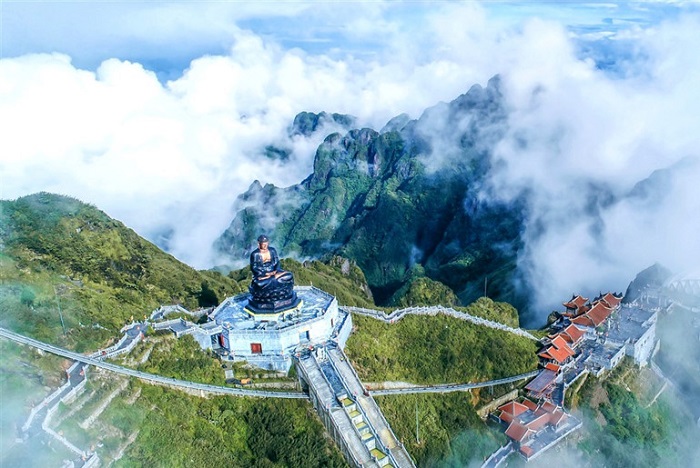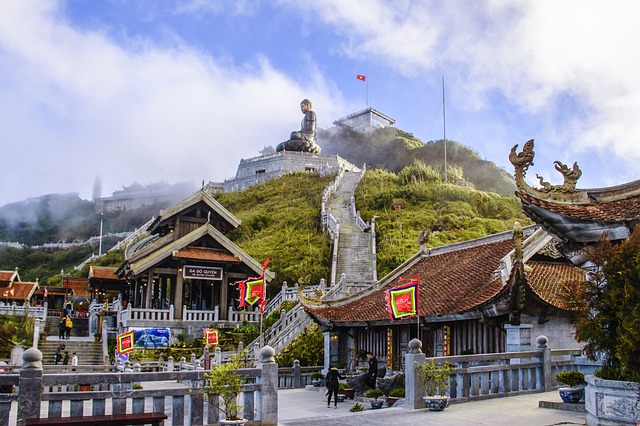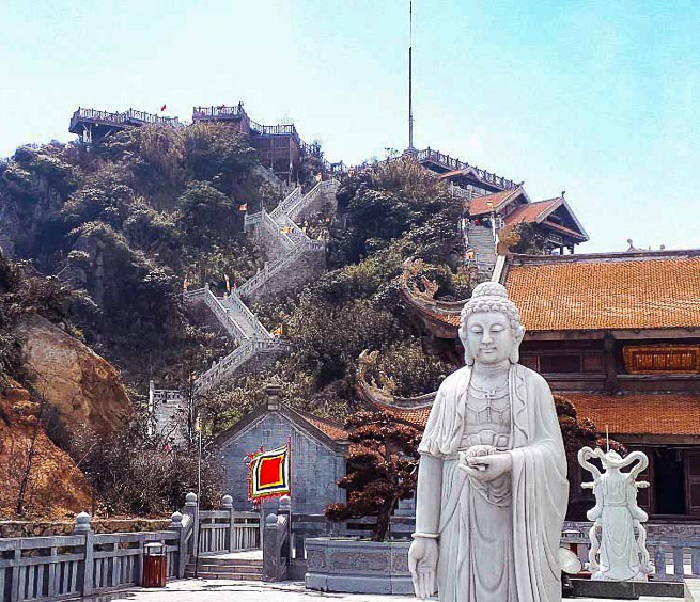Kim Son Bao Thang Tu Pagoda
1. Overview
Kim Sơn Bảo Thắng Tự is a prominent Buddhist temple situated at an elevation of 3,091 meters on Fansipan Mountain, the highest peak in Vietnam and Indochina.
-
Location: Fansipan Mountain, Sapa, Lao Cai Province, Vietnam
-
Established: Construction began in 2015 and was completed in 2018
-
Elevation: 3,091 meters above sea level
2. Architectural Design
The temple is designed in the traditional Vietnamese Buddhist architectural style, incorporating elements from ancient wooden pagodas such as Chùa Thái Lạc in Hưng Yên, Chùa Thầy in Hanoi, and Chùa Bối Khê in Thanh Oai.
-
Layout: The temple follows the "tiền Phật, hậu Thánh" design, with the front dedicated to the Buddha and the rear to the Holy Mother.
-
Materials: Constructed using natural wood and stone, with roofs made of wooden tiles or glazed ceramic, reflecting the architectural style of the Thang Long Imperial Citadel.
-
Dimensions: The temple comprises five main halls, with a front courtyard approximately 30 meters wide.
3. Notable Features
-
Main Hall (Đại Hùng Bảo Điện): Houses numerous meticulously crafted wooden statues of Buddhist deities, including Thích Ca Mâu Ni, Tam Thế Phật, Quan Âm Chuẩn Đề, Mục Liên, Địa Tạng, and Phật Di Lặc.
-
Bell Tower (Vọng Lĩnh Cao Đài): A five-story structure standing 35 meters tall, resembling the architecture of ancient pagodas like Chùa Tây Phương and Chùa Bút Tháp.
-
Statues:
-
Phật A Di Đà: The largest bronze statue of Amitabha Buddha in Vietnam, standing at 21.5 meters tall.
-
Quan Thế Âm Bồ Tát: A 9-meter-tall bronze statue of Avalokiteshvara, situated at the end of the La Hán Path.
-
-
La Hán Path: Features 18 bronze statues of Arhats, each 2.5 meters in height, showcasing the craftsmanship of Vietnamese artisans.
4. Spiritual and Cultural Significance
Kim Sơn Bảo Thắng Tự serves as a spiritual sanctuary for Buddhists and visitors seeking tranquility and reflection. It is a prominent destination for pilgrimages, especially during the Lunar New Year and other significant Buddhist festivals.
-
Pilgrimage Site: A place for worship, meditation, and seeking blessings for health and prosperity.
-
Cultural Landmark: Reflects the rich Buddhist heritage and architectural traditions of Vietnam.
5. Visiting Information
-
Access: Visitors can reach the temple via the Fansipan Cable Car, followed by a short walk of approximately 600 steps to the temple.
-
Best Time to Visit: The ideal months are from October to December, offering clear skies and mild temperatures.
-
Preparation: Due to the high altitude, it's advisable to wear warm clothing and comfortable footwear. Visitors should also be prepared for cooler temperatures compared to Sapa town.
6. Conclusion
Kim Sơn Bảo Thắng Tự is not only a place of worship but also a testament to Vietnam's rich cultural and architectural heritage. Its serene environment and majestic structures make it a must-visit destination for those traveling to Sapa.




